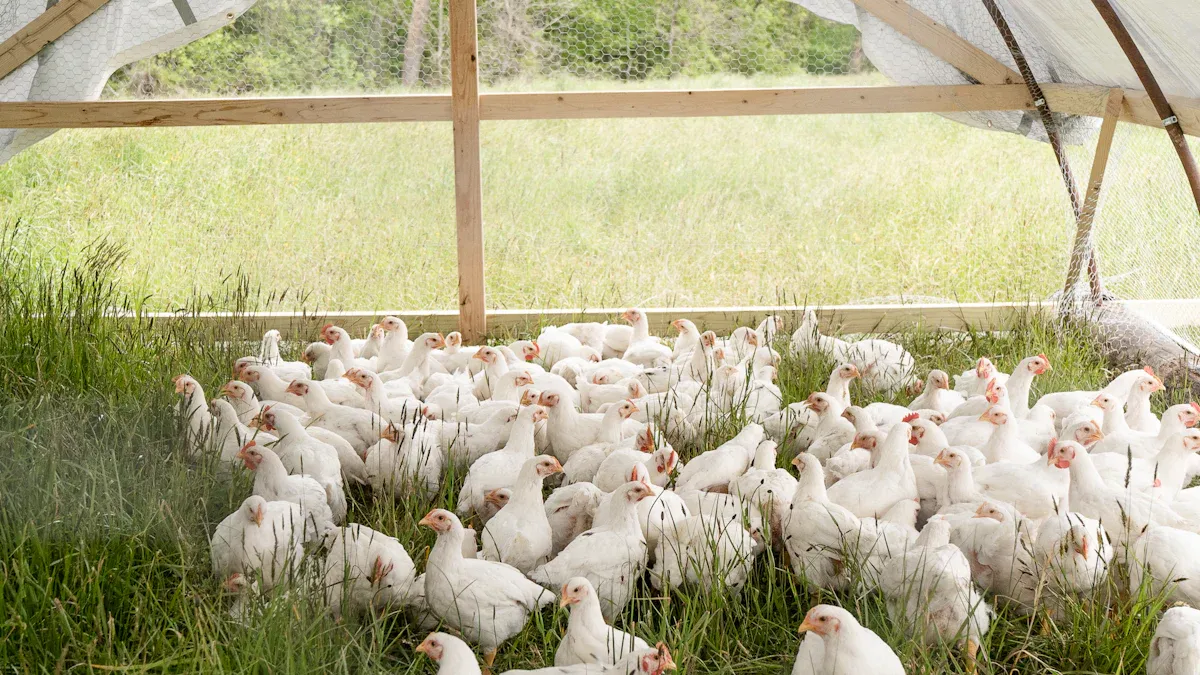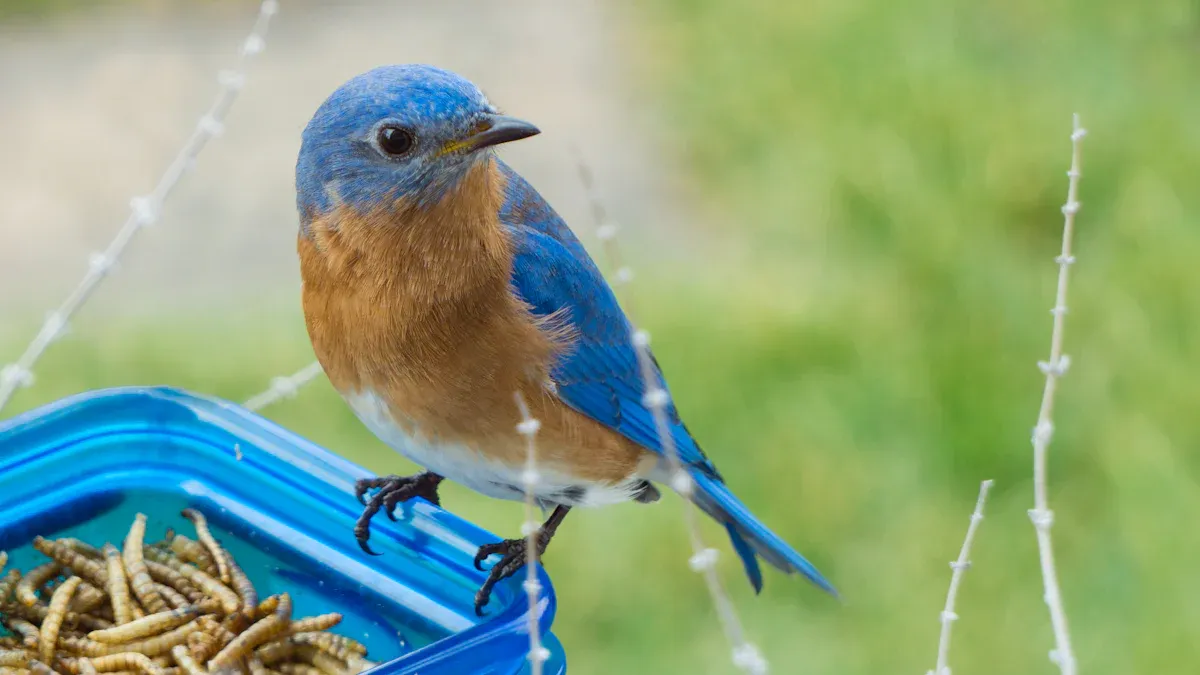
Imagine feeding your chickens a nutritious treat that’s affordable and sustainable with mealworms for chickens. In 2025, EU-compliant mealworms are revolutionizing poultry farming. These nutrient dried mealworms boost chicken health while cutting costs for farmers. You’ll love how they improve egg quality and support eco-friendly practices. It’s a win-win for your flock and the planet.
Key Takeaways
- Mealworms are healthy snacks for chickens. They improve health and eggs.
- Feeding mealworms makes eggs better with harder shells and brighter yolks.
- Mealworms are good for the planet. They lower farming pollution.
Benefits of Mealworms For Chickens
Nutritional Value and Health Benefits
Mealworms are a powerhouse of nutrition for your chickens. Packed with protein, they help your flock grow stronger and repair their bodies. They’re also rich in fats, which give your chickens energy and help them absorb vitamins. Plus, mealworms contain fiber for better digestion and minerals like phosphorus to keep their bones healthy.
Here’s what makes mealworms so beneficial:
- They support the immune system, keeping your chickens healthier.
- They improve feather quality, especially during molting.
- They encourage natural foraging, which boosts mental and physical health.
Adding mealworms to your chickens’ diet doesn’t just make them healthier—it makes them happier too.
Enhancing Egg Production and Quality
If you want better eggs, mealworms are the way to go. Chickens fed with mealworms lay eggs more consistently. The eggs often have thicker shells and richer yolks, which means better quality for you and your customers.
Here’s how mealworms help:
- Healthier hens produce eggs more regularly.
- The yolks become darker and more vibrant, packed with nutrients.
- Shells get stronger, reducing breakage.
You’ll notice the difference in both the size and flavor of the eggs. It’s a simple way to improve your flock’s productivity.
Promoting Sustainability in Poultry Farming
Mealworms aren’t just good for your chickens—they’re good for the planet too. They’re easy to raise and require fewer resources than traditional feed. This makes them an eco-friendly choice for poultry farming.
Studies show that using mealworms can lower greenhouse gas emissions and reduce the environmental impact of feed production. Whether you run a small farm or a large operation, mealworms offer a sustainable solution that benefits everyone.
By choosing mealworms for chickens, you’re not only improving your flock’s health but also contributing to a greener future.
Making EU-Compliant Mealworms Affordable in 2025
Advances in Mealworm Farming Technology
Technology is making mealworm farming faster, cheaper, and more efficient. Hybrid drying systems, which combine microwave and hot-air technologies, are leading the way. These systems cut energy use by 30%, helping farmers save money while keeping production sustainable. Companies like Ynsect and Protix use industrial-scale dryers to meet growing demand across Europe and North America.
Other equipment, like belt dryers and fluidized-bed dryers, ensures mealworms retain their nutrients by achieving moisture levels below 10%. These advancements mean you can get high-quality mealworms for chickens without breaking the bank.
Cost Savings Through Bulk Purchasing and Local Sourcing
Buying mealworms in bulk and sourcing them locally can save you a lot of money. Bulk purchasing reduces packaging costs and allows suppliers to offer discounts. Local sourcing cuts transportation expenses, making mealworms even more affordable.
Regional agricultural policies also play a role. For example, the Common Agricultural Policy (CAP) supports energy-efficient drying systems, reducing costs by 30-40%. Farmers who take advantage of these savings can pass the benefits on to you.
Here’s a quick look at the factors driving affordability:
| Factor | 이름 * |
|---|---|
| Regional Agricultural Policies | Financial incentives and subsidies under CAP support energy-efficient drying systems, reducing costs by 30-40%. |
| Technological Advancements | Increased installations of hybrid drying systems in the Netherlands, with a 200% rise since 2021, enhance efficiency and lower operational costs. |
| Sustainability Certifications | 68% of European bioeconomy investors prioritize third-party certifications, influencing purchasing decisions and market competitiveness. |
Support from Government Subsidies and Incentives
Governments across Europe are making it easier for farmers to produce affordable, EU-compliant mealworms. CAP subsidies promote circular agriculture and reduce waste in mealworm production. Farms that meet sustainability standards can get 30-40% of their equipment costs covered.
France is leading the charge with its 2022 initiative, which dedicated €70 million to insect production facilities. These facilities use advanced drying technologies to lower costs and boost efficiency. With these incentives, mealworms for chickens are becoming a cost-effective option for farmers like you.
Practical Use of Mealworms For Chickens

How to Mix Mealworms with Regular Feed
Mixing mealworms into your chickens’ feed is simple and effective. Start by adding a small amount—around 5-10% of the total feed. This ensures your flock gets the nutritional benefits without risking imbalances. Gradually increase the amount if needed, but always keep mealworms as a supplement, not the main feed.
Here’s a quick guide to mixing:
- Combine mealworms with grains or pellets to create a balanced diet.
- Use dried mealworms for easy storage and longer shelf life.
- Sprinkle mealworms on top of the feed to encourage foraging behavior.
Mealworms enhance digestion, boost immunity, and improve feather quality. By mixing them with regular feed, you’ll give your chickens a well-rounded diet that supports their overall health.
Feeding Guidelines and Best Practices
Feeding mealworms to chickens requires a few best practices to keep your flock healthy. Moderation is key. Overfeeding can lead to overweight chickens, so limit mealworms to 10% of their diet.
Follow these tips for success:
- Always provide grit to help chickens digest mealworm exoskeletons.
- Monitor your flock’s health and adjust the amount of mealworms as needed.
- Observe how your chickens react to mealworms and make changes based on their growth and egg production.
팁: Mealworm larvae are especially beneficial for gut health, improving nutrient absorption and digestion.
By sticking to these guidelines, you’ll maximize the benefits of mealworms while keeping your chickens in top shape.
Transitioning Chickens to a Mealworm-Based Diet
Introducing mealworms to your chickens’ diet should be a gradual process. Start with small amounts and observe how your flock responds. Chickens generally adapt well to mealworms, but a slow transition ensures they adjust without any issues.
Research shows that yellow mealworm larvae can safely enhance gut health and improve overall nutrition. Begin by mixing a handful of mealworms into their regular feed. Over time, you can increase the amount based on their health and production needs.
참고 : Mealworms for chickens are safe and effective, but always monitor your flock for any changes in behavior or health.
A smooth transition will help your chickens enjoy the benefits of mealworms without any stress.
Adhering to EU Regulations for Mealworms
Overview of EU Standards for Livestock Feed
When it comes to feeding your chickens mealworms, staying compliant with EU regulations is essential. These rules ensure that the feed is safe, nutritious, and free from harmful substances. The EU has set clear standards for livestock feed, covering everything from pesticide residues to undesirable substances like dioxins.
Here’s a quick look at some key regulations:
| Regulation | 이름 * |
|---|---|
| Commission Regulation (EU) 2017/771 | Amends methods for determining levels of dioxins and polychlorinated biphenyls. |
| Commission Regulation (EU) No 691/2013 | Updates sampling and analysis methods for feed safety. |
| Directive 2002/32/EC | Focuses on limiting undesirable substances in animal feed. |
| Regulation (EC) No 396/2005 | Sets maximum residue levels for pesticides in food and feed. |
These guidelines help you provide your chickens with mealworms that meet the highest safety and quality standards.
Ensuring Mealworm Safety and Quality Compliance
You want to make sure the mealworms you use are safe and high-quality. Start by sourcing them from certified suppliers who follow EU-approved farming and processing methods. Look for products with third-party certifications, as these often guarantee compliance with EU standards.
Always check the packaging for details about moisture content, pesticide levels, and other safety indicators. Mealworms with moisture levels below 10% are ideal because they’re less likely to spoil. By choosing the right suppliers and products, you’ll keep your chickens healthy and your farm compliant.
팁: Regularly review EU updates on feed regulations to stay ahead of any changes.
Avoiding Common Regulatory Mistakes
Mistakes can happen, but you can avoid them by staying informed. One common error is overlooking the maximum residue levels for pesticides. Always verify that your mealworms meet the limits set by Regulation (EC) No 396/2005.
Another pitfall is failing to document your feed sources. Keep records of where you purchase your mealworms and any certifications they carry. This not only ensures compliance but also builds trust with your customers.
By following these steps, you’ll avoid regulatory headaches and keep your chickens thriving.
EU-compliant mealworms are a game-changer for poultry farming. They’re affordable, packed with protein, and great for your chickens’ health. Plus, they’re eco-friendly!
- They improve feather quality and egg production.
- They keep chickens warm in winter.
- Farming mealworms produces less greenhouse gas.
Switching to mealworms supports your flock and the planet. Why wait? 🐔
제품 정보
What are the benefits of using mealworms for chickens?
Mealworms provide high protein, improve digestion, and boost egg quality. They also promote natural foraging behavior, keeping your chickens active and healthy.
How often should I feed mealworms to my chickens?
Limit mealworms to 10% of their diet. Feed them as a treat or supplement a few times a week for the best results.
Are mealworms safe for chickens to eat?
Yes, mealworms are safe and nutritious. Just ensure they come from certified suppliers to meet EU standards and avoid harmful substances.


